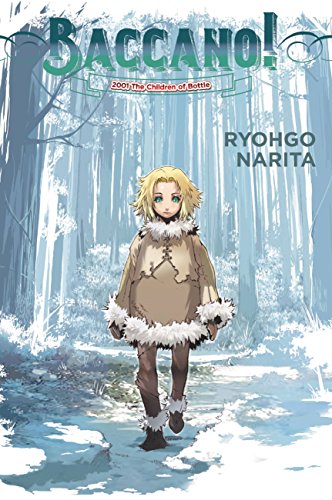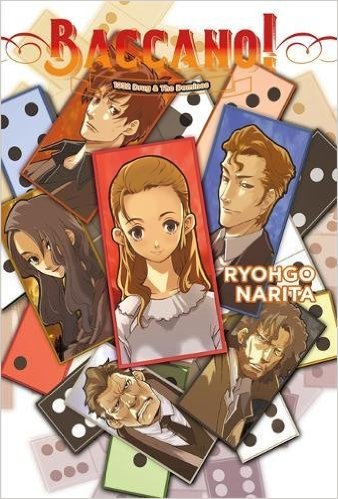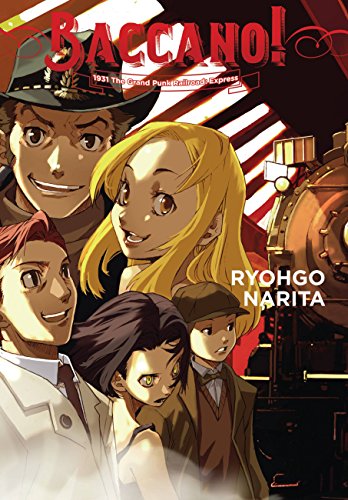By Ryohgo Narita and Katsumi Enami. Released in Japan by ASCII Mediaworks. Released in North America by Yen On. Translated by Taylor Engel.
This must have been quite startling to readers at the time, and it’s still pretty startling. The first four books in this series all took place around the same two year period, and there was no reason to expect anything else. Thus suddenly jumping forward to 2001 is jarring, even if you do know intellectually that a large number of the cast are Immortals. Furthermore, Isaac and Miria, bar a cameo at the start (which ended up being used in the anime) and the end, are absent from this book. But that’s OK, because we are introduced in this book to Elmer C. Albatross, a man with so much sheer force of personality that he tends to overwhelm the narrative when he’s in it. Having him interact with Isaac and Miria would be like eating something too sweet. Best to have moderation. That said, this is still an excellent volume of Baccano!.
The girl on the cover is Fil, and she is essentially the heart of this book. (To avoid too many spoilers, I will try not to refer to her as Fil and the Filtones.) The basic premise has Maiza and Czeslaw, who we’re familiar with from previous books, searching the world for the remaining immortals from the 1711 ship journey where they gained said immortality. The goal is to tell said immortals they can stop hiding, as Szilard is now dead. They pick up two more for this journey: Sylvie, a gorgeous women who was hell-bent on nothing but revenge on Szilard and has to figure out what to do now that someone else got there first; and Nile, a large North African man who has spent his immortality fighting in wars and wears a mask because his face no longer shows emotions when doing things like killing people. They are now all arriving at a tiny village in the middle of nowhere in Europe, where Maiza has been told he may find Elmer. He does find Elmer, but also finds what Elmer’s been doing for the last few years: trying to make everyone smile.
Elmer is one of the most awaited introductions for longtime Baccano! fans, and he doesn’t disappoint. As I said earlier, on the surface he might seem a bit like Isaac and Miria, but that’s just the surface. Elmer is a bit broken, and his quest for smiles at any cost, no matter how inappropriate the time, no matter if he’s talking about a killer, no matter if it involves selling everyone’s soul – it’s just disturbing when you dig down into it. He’s doing the right thing here, but it’s not really for the right reason, and yet in the end you can’t help but love Elmer, even as you find him vaguely disquieting – I suspect if I met him in real life he’d be unbearable. (I suspect that about a lot of Baccano! characters.) The rest of the cast also get stuff to do – Czes shows that years and years of physical, mental and emotional abuse can still affect you even almost a hundred years later, Sylvie gets to be sympathetic and sweet (mostly; she’s noticeably different when only around the other immortals), and Nile at first seems to be comic relief till an absolutely stunning speech that rips into a character’s desire to end their life with beautiful precision.
Speaking of Nile, let’s talk translation. Baccano! has a large fan community who translated many of the books before they were officially licensed. That hasn’t been an issue before this, as the first four books had fan translations ranging from adequate to awful. 2001, though, had a really good translation, so I was concerned fans would be wedded to that and object to anything different. That said, having finished the book, I think we’re good. The main concern is Nile’s way of speaking. He has a habit of prefacing his sentences with “Let me just say this:” and variations, which emphasizes his declamatory language and also shows a bit that he’s constantly asking permission to speak, something Maiza calls him out on. The fan translation had “I say this:” which is more literal but not as smooth. I think Taylor Engel does a very good job of making each character’s speech pattern distinct, which is important, as not everyone’s dialogue is as eccentric as Nile’s.
I haven’t talked much about the actual plot of the book, but that’s because it’s one of those books where I don’t want to give away the surprises too much. Suffice it to say I found it very enjoyable, and think you will as well. And if you’re annoyed that we don’t get more of Firo, or Isaac and Miria, or Jacuzzi and Nice, well, we’re back to the 1930s with the next five books.
Oh yes, and ‘Children of Bodom’ is the title reference, a Finnish metal band.





